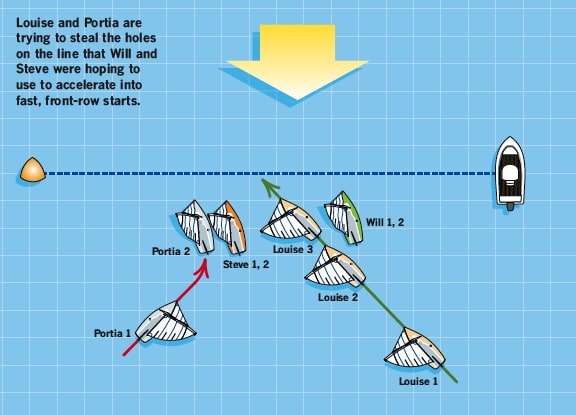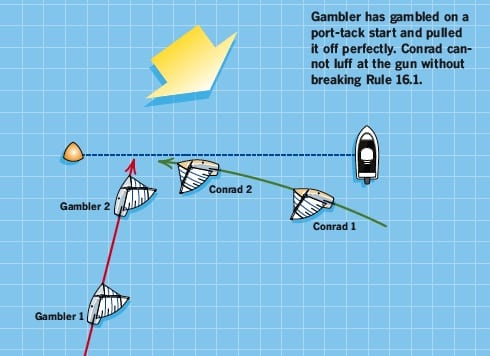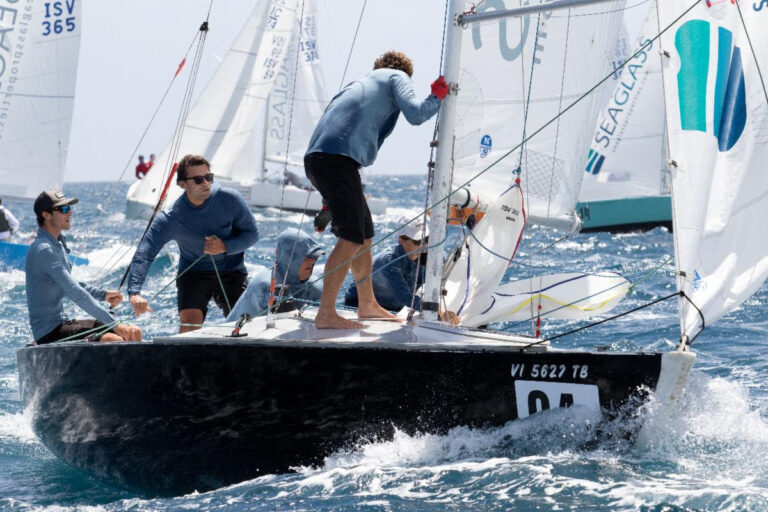Boats are frequently packed close together in the final countdown to the start, and as a result, the rules get a real workout. Thankfully, the rules that apply at a starting mark are significantly simplified because no Section C rule applies at a starting mark surrounded by navigable water (see the preamble to Section C).
So what sailboat racing rules apply at the starting line? They are the same rules that apply in open-water situations. Between any pair of boats, one—and only one—of the basic right-of-way rules in Section A applies at any given moment, and that rule confers right of way on one of the pair and the obligation to keep clear on the other. Three “General Limitation” rules from Section B limit changes of course by the right-of-way boat. These are, in order of importance, Rule 16.1, Changing Course, Rule 14, Avoiding Contact, and Rule 15, Acquiring Right of Way.
You can either aim for a front-row start somewhere in the middle of the pack or, when one end of the line is favored, try to nail the start at the favored end. Let’s apply the rules to each of these starts.

The first diagram shows two typical mid-line situations that occur often in a large fleet of dinghies. Will and Steve have each set up on the windward side of a hole rather early and are barely moving forward on starboard tack. Louise and Portia come in later, both sailing at normal speed, and intent upon occupying the spaces that Will and Steve have been planning to use to bear away and accelerate in the final seconds before the start.
At Position 1, Louise is clear astern of Will and required by Rule 12 to keep clear. Because she is moving much faster than Will, Louise anticipates that she will soon have a leeward overlap on Will and begins to warn Will by hailing “Go up, don’t come down.” If Louise hails while still clear astern, her hail is totally inappropriate and toothless. As long as Will is clear ahead, he is under no obligation to take any action to avoid Louise. As the right-of-way boat, Will can make any course change he wishes provided that, as he does so, he gives Louise room to keep clear (see Rule 16.1).
At Position 2, Louise becomes overlapped to leeward of Will. At that time Rule 12 no longer applies and is replaced by Rule 11, which gives Louise right of way. However, at the moment of transition, Rule 15 requires Louise to give Will room to keep clear. Rule 15 only applies initially—that is for a few seconds after the overlap begins. However, at all times while Louise remains overlapped to leeward of Will, she is bound by Rule 16.1 if she changes course. Louise intends to luff up to enlarge the hole to leeward of her and to deprive Will of any gap in which to accelerate. If Louise were to luff up at Position 2, she certainly would break Rule 16.1 because, if Will tried to luff in response, his stern would swing into the starboard side of Louise’s bow. To avoid breaking Rule 16.1, Louise should delay any luff until she reaches Position 3, at which point there will be room for Will to keep clear.
Portia has her eye on the hole that Steve intends to use. While she is on port tack, and from the time she passes head to wind until she assumes a close-hauled course on starboard tack, Will has right of way, first under Rule 10 and later, afer Portia passes head to wind, under Rule 13. At Position 2, Portia is still required to keep clear under Rule 13. She wants to force Steve to remain in the position he is in. To do so, she must first obtain right of way, by bearing off to a closehauled course momentarily, and then luff again. To improve her chances in the protest room should Steve protest her for breaking Rule 13, Portia should hail, “Closehauled, keep clear” when she is first on a closehauled starboard-tack course.

Now, let’s assume the starboard end of the line is favored and examine how the rules apply to boats vying for the best start at that end. Take a look at the second diagram, where Larry and Wilma are overlapped on starboard tack approaching the stern of the committee boat at the starboard end of the line. Larry has right of way under Rule 11. At Position 1, he can luff Wilma without breaking Rule 16.1 because there is plenty of room for Wilma to keep clear. However, at Position 2 Larry may no longer luff Wilma, because doing so would force her to hit the committee boat. Rule 16.1 requires Larry to give Wilma the “space [she] needs . . . while maneuvering [to keep clear] promptly in a seamanlike way.” Touching a mark (even if there is no damage) is not considered “seamanlike” (see new ISAF Case 114). so a leeward boat intending to “shut the door” on a barging windward boat must do so while there is still room for the windward boat to pass to starboard of the committee boat.

Finally, look at the third diagram. There, the port end of the line is favored. Gambler is trying to port-tack the fleet, while Conrad is cautiously setting up for a start on starboard tack at the pin. Gambler has positioned his boat and timed his run at the line perfectly. The starting gun is fired while the boats are at Position 2, just before Gambler’s bow crosses the line. If Conrad holds his course, Gambler will cross ahead with no need for Conrad to take avoiding action. Conrad was reaching below the line on starboard tack, intending to head up at the start. However, if Conrad were to luff immediately after Position 2, there would be no way that Gambler could keep clear without hitting the mark. Therefore, such a luff by Conrad would break Rule 16.1. Conrad’s cautious approach has backfired. Now, to avoid breaking Rule 16.1, he is forced to hold his course until Gambler has crossed ahead. At that point, Conrad will probably have to jibe around below the line and make a late and risky approach to the line on port tack. The lesson here is clear. If you are trying for the pin-end start on starboard tack and you see a boat setting up for a port-tack start, you should slow up so that, at the gun, you are far enough from the pin to enable you to luff without depriving the port-tack starter of room to keep clear.
Contact Rules at the Starting Line
Rule 14 requires all boats, at all times, to “avoid contact with another boat if reasonably possible.” A boat includes all her equipment and her crew (see Terminology in the Introduction to the rulebook). Therefore, if a windward boat’s mainsheet brushes the shoulder of the leeward boat’s crew, it’s contact. Also, if your crew thinks contact is about to occur and fends off to avoid damage, then, when your crew touches the other boat’s hull, it’s contact. There
is an understandable impulse to push an offending boat backward and to push your own boat forward when fending off. Resist it! In addition to raising the hackles of the other boat’s crew, fending off in such a manner breaks Rule 42.1, Propulsion, and probably Rule 2, Fair Sailing, as well.









